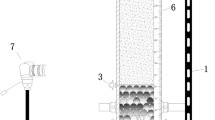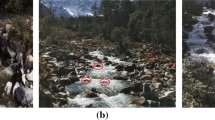Conclusions
-
1.
The results obtained (Figs. 1, 2, and 3) make it possible, without relating the calculation to the dimensions of the sand ripples, to determine λ, H, and v by the method of selection using Chezy's relationship, if i, the flow rate Qa and the water temperature, the fineness of the sand, and the cross section of the water course are known (i is equated to the slope of the free surface). In this case, the average value of the exponent N in relationship (22) (N=1.05 for small water courses and hydraulic flumes, H≤1.0 m, and N=1.08 for large water courses, \s>1.0 m) can be assigned as its value. The calculation should be performed within the above-indicated limits of variation in λ and the relative start-off velocities in accordance with the following sequence: a) based on the fineness of the sand, n* can be established from the curve presented in Fig. 3; b) a number of values of the average depth H can be assigned, and the corresponding values ofω determined — the area of the active section, v*, R, Re*d, and λ from (22),\(C = \sqrt {2g/\lambda } \), and the flow rate\(Q = \omega C\sqrt {Ri} \); and, c) the Q=f(H) curve from which the computed depth values Hc corresponding to the assinged flow rate Qa, and then the velocity of the flow vc can be constructed.
The error associated with the accuracy of the λ determination is within 5%.
-
2.
The v and H in hydraulic flumes and small water courses (H≤1.0 m, d50≤0.38−0.37 mm) are also calculated by selection using the Chezy relationship and (24) for the region Re=103−3.2·104 and from
$$\lambda = 10^{0,5511g^2 \operatorname{Re} - 5,131g Re + 11} $$for the region Re=3.2·104−106. The error is within the range of 20%.
Similar content being viewed by others
Literature cited
B. F. Snishchenko, “Movement of sand ripples in natural water flows,” Tr. Gosudar. Gidrolog. Inst., No. 136, (1966).
B. F. Snishchenko, “Channel deformations in large canals,” Interzonal Redistribution of Water Resources [in Russian], Gidrometeoizdat, Leningrad (1980).
N. S. Znamenskaya, “Experimental investigation of the bed movement of alluvial material,” Tr. Gosudar. Gidrolog. Inst., No. 108, (1963).
N. N. Kulemina, “On field investigations of the channel process in a flood,” Tr. Gosudar. Gidrolog. Inst., No. 147, (1968).
Yu. M. Korchokha, “Investigation of the bed movement of alluvial material on the Polometa River,” Tr. Gor'kov. Politekh. Inst., No. 161, (1968).
N. E. Kondrat'ev, I. V. Popov, and B. F. Snishchenko, Fundamentals of Hydromorphologic Theory of Channel Flow [in Russian], Gidrometeoizdat, Leningrad (1982).
Z. D. Kopaliani, “Laboratory investigations of the bed movement of coarse alluvial material,” Tr. Gosudar. Gidrolog. Inst., No. 204, (1972).
H. P. Guy, D. B. Simons, and E. B. Richardson, Summary of alluvial channel data from flume experiments, 1956–1961, U.S. Geological Survey Professional Paper 462-1, Washington (1966).
K. Shinohara and T. Tsubaki, “On the characteristics of sand waves formed upon the beds of open channels and rivers,” Reports of Research Institute for Applied Mechanics,7, No. 25, 15–45 (1959).
T. Tsubaki, T. Kawasumi, and T. Yasutomi, “On the influences of sand ripples upon the sediment transport in open channels,” Reports of Research Institute for Applied Mechanics, Kyushu Univ. (Japan),11, No. 8, 241–256 (1953).
K. V. H. Smith, “Similarity in unlined irrigation canal systems,” J. Hydraul. Div. Proc. Am. Soc. Civ. Eng.,96, No. HY1, 16–19 (January, 1970).
D. B. Simons and M. L. Albertson, “Uniform water conveyance channels in alluvial material,” J. Hydraul. Div., Proc. Am. Soc. Civ. Eng.,86, No. HY5, 44–45 (May, 1960), Table 3 — Summary and Bender Data.
P. Ackers and W. Rodney, “Sediment transport: new approach and analysis,” J. Hydraul. Div., Proc. Am. Soc. Civ. Eng.,99, No. HY11, 2051–2052 (November, 1973).
E. M. Joursen, “The total sediment load of streams,” J. Hydraul. Div., Proc. Am. Soc. Civ. Eng.,84, No. HY1, Part 1, 1530–1532 (February, 1958).
G. A. Griffiths, “Flow resistance in coarse gravel river beds,” J. Hydraul. Div., Proc. Am. Soc. Civ. Eng.,107, No. HY7, 904–907 (July, 1981).
Additional information
Translated from Gidrotekhnicheskoe Stroitel'stvo, No. 12, pp. 22–26, December, 1990.
Rights and permissions
About this article
Cite this article
Meskheli, K.P. Hydraulic resistance of sand ripples. Hydrotechnical Construction 24, 747–755 (1990). https://doi.org/10.1007/BF01434600
Issue Date:
DOI: https://doi.org/10.1007/BF01434600




